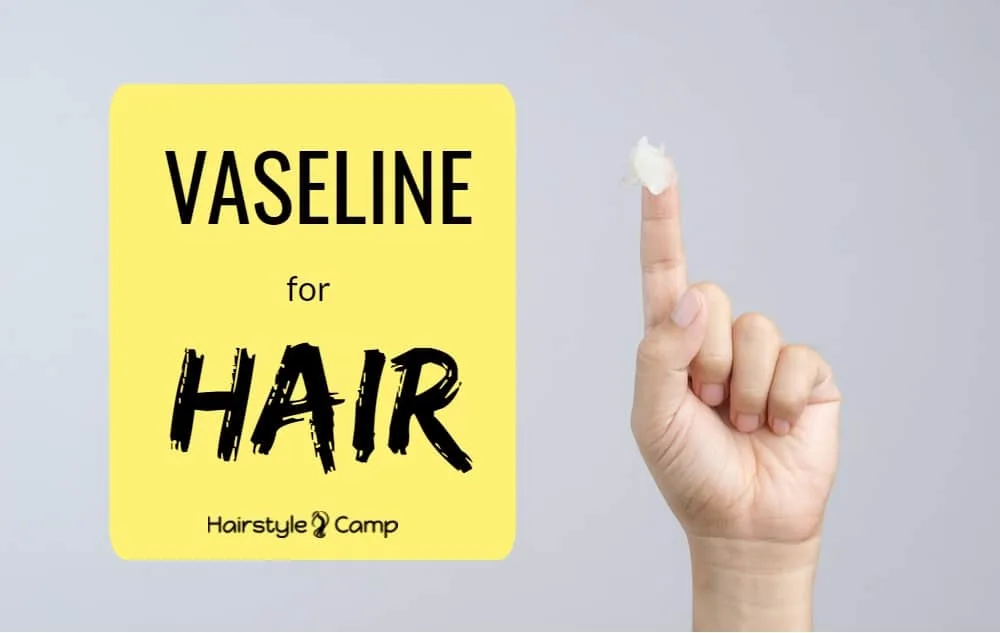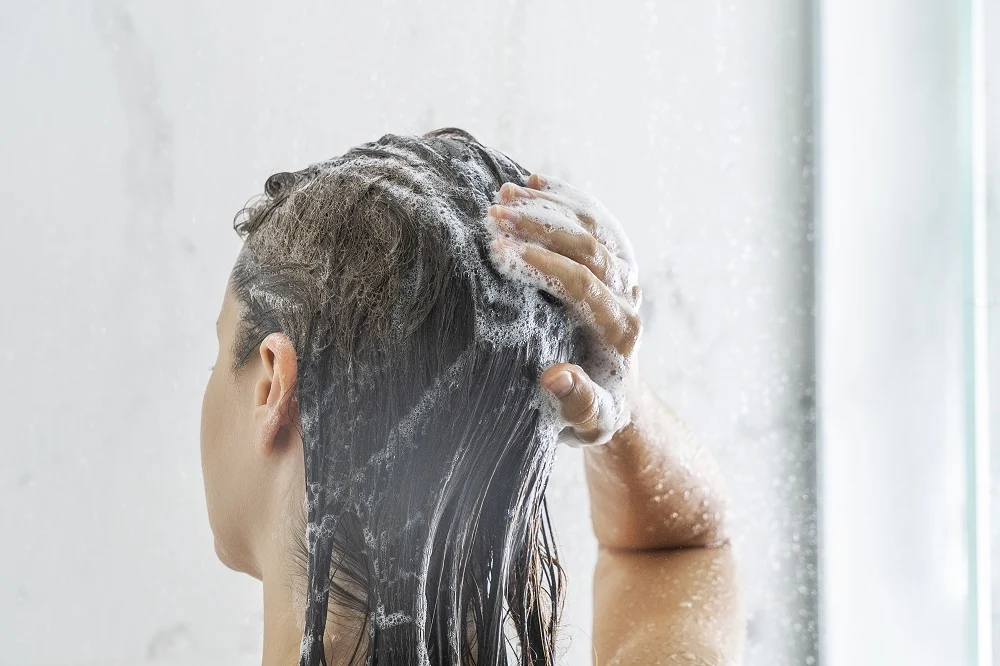Vaseline has been used for hair care ever since we can remember. Most of us live in homes that have at least one tub of Vaseline that seems to be sitting around forever on a bathroom shelf or in a medicine cabinet.
When we were kids, worried moms wiped globs of it on our mouths to prevent us from getting chapped lips, and sometimes these same moms used it to soothe the dry, calloused skin on their own elbows or feet. They even applied Vaseline for hair treatments when there were no other options on hand at home.
Is Using Vaseline For Hair a Good Idea?
Even though it’s common knowledge that using Vaseline for hair helps control annoying frizzies and flyaways, have you ever wondered about other, less common ways of using it? You might be surprised to learn that using Vaseline helps solves some other haircare problems too.
What Exactly is Vaseline?
Vaseline is a product brand name for a substance known as petroleum jelly, and the words can be used interchangeably. Petroleum jelly is a semi-solid combination of mineral oils and natural waxes that, when blended, form a gooey, sticky ointment that can be easily wiped or spread over any bodily surface.
The reason that the subject of using Vaseline for hair comes up so often is that it’s known for its ability to lock in moisture where you want it locked in, and repel moisture and water where you want it repelled. Because petroleum jelly doesn’t penetrate tissues or cells, it’s not an adequate substitute for moisturizing skin lotions or hair conditioners.
How to Use Vaseline for Hair

Most people are aware that petroleum jelly can be used as a scalp conditioner, hair gel substitute, split end tamer, or as a styling pomade to add shine to your hair. You may have also figured out that using it to coat your ears and hairline will protect your skin from staining when using home hair dye kits.
But there are a few other ways to use Vaseline for hair that you might not be aware of:
Hair straightener
- Try a mixture of 1 tbsp. Vaseline, 1 tbsp. hair tonic, 2 tbsp. castor oil, 2 tbsp. aloe vera gel from a tube, 2 yellow vitamin E capsules and 2 beaten eggs to do a fabulous job of straightening coarse, wavy hair.
- Apply the cream thoroughly to slightly damp hair, covering all the strands.
- Leave it in for at least 30 minutes, and then wash and condition.
- Blowdry using the “cool” setting and enjoy sleek, smooth, and silky straight hair.
Protective Hair Mask and Overnight Pre-poo:
- In a small bowl, combine 1 tsp. petroleum jelly, 1 tsp. olive oil, 1 vitamin E capsule, and ½ tsp. fresh lemon juice and blend thoroughly.
- Apply the mixture to dry hair and leave it overnight.
- Wash your hair the next morning with a gentle shampoo and style as usual.
- Use this method at least three times a week to promote hair growth.
Swim Protection
If you enjoy swimming in a pool as a frequent form of exercise or recreation, you know the havoc that chlorinated water can cause to your hair. Try using Vaseline for hair protection the next time you jump in the water.
- Take a small amount of Vaseline.
- Rub it in the palms of your hands.
- Then rub your palms and fingers through your hair until the strands are coated with a light film of the petroleum jelly.
Vaseline is challenging to remove from long hair, so this particular water barrier technique works best if you have short hair and don’t use bathing caps when you swim in pools.
How Not to Use Vaseline for Hair
Avoid questionable advice suggesting that you use petroleum jelly to kill head lice or to turn gray hair black; we haven’t found any credible data that proves those claims.
Benefits of Vaseline for Hair

There are several possible benefits to using vaseline for hair. The main advantage for hair is that it locks in moisture. It doesn’t have any moisturizing properties, but petroleum jelly seals in the hair’s existing moisture.
Vaseline is particularly helpful for addressing split ends. A small amount of vaseline on split ends will help prevent breakage. Some people use it as a simple alternative to hair gel. Additionally, you can use it to remove flakes in the hair caused by dandruff and other scalp irritations.
Side Effects
While vaseline can be helpful for some hair care needs, there are possible side effects. Applying petroleum jelly directly to your scalp can cause a few issues. The thick petroleum jelly can clog pores, damaging hair follicles and creating an environment for bacteria to grow.
It can help remove flakes from your hair, but there is no evidence that it will help improve your scalp health or solve the root cause of a flaky scalp. Instead, the buildup of petroleum jelly could further aggravate scalp irritation.
However, conservative use of vaseline focused on the ends of the hair with minimal scalp application is still safe and beneficial.
How to Remove Vaseline from Hair

One of the biggest challenges of using vaseline for hair is getting it out. The sticky, thick texture of jelly makes it extremely difficult to wash out.
You will need a clarifying shampoo to get vaseline out of your hair. Use warm water to wet your hair, and then apply shampoo. If you used a large amount, you will probably need to do multiple rounds of shampooing and rinsing to remove it fully.
If regular shampoo isn’t enough to get all the vaseline out of your hair, try using baking soda. Baking soda has natural cleansing properties, so using about a teaspoon of baking soda mixed with shampoo should help strip the petroleum jelly out of your hair.
Key Takeaways
- Vaseline or petroleum jelly isn’t a substitute for moisturizing lotion or hair conditioners as it doesn’t penetrate the skin.
- Use it to coat ears and hairline to prevent it from staining.
- Petroleum jelly can be used as a hair straightener and protective hair mask.
- It can be used to protect hair from the Chlorine water of the swimming pool.
- Vaseline doesn’t kill lice nor it helps to turn gray hair into black.
Frequently Asked Questions
Here are answers to some of the most frequently asked questions about vaseline for hair.
Yes, vaseline doesn’t make hair grow faster. There are no nutrients in it that promote hair growth or benefit hair follicles. If you use too much in your hair, you may experience a buildup of petroleum jelly, which can cause scalp irritation and blockages in your hair follicles.
While follicle blockages and scalp irritation can limit hair growth or cause hair loss, using vaseline on the ends of your hair may be slightly beneficial to hair growth. Locking in moisture will protect your hair and prevent breakage, keeping your hair healthy as it grows out.
Yes, vaseline may cause hair loss if used too much, particularly when you use it on the scalp. Hair damage may occur if the petroleum jelly builds up to the point that it irritates your scalp, attracts bacteria, or clogs your hair follicles.
Healthy hair follicles are the key to healthy hair growth. If a hair follicle is too damaged, it can fall out and new hair won’t grow in its place.
Yes, vaseline is a great way to lock in moisture and smooth out frizzy hair. Frizz is caused by dehydrated hair and it can both weigh the hair down and keep it from losing moisture.
Yes, you can leave petroleum jelly in your hair for a few hours. Some people wear it as a mask overnight. Leaving these in your hair for several hours can help keep your hair moisturized and in place.
However, since vaseline can be hard to wash out and tends to clog skin pores and hair follicles, you shouldn’t leave the jelly in your hair for longer than one night’s sleep.
Vaseline is useful for preventing split ends from getting worse. The petroleum jelly functions as a seal to keep moisture and protect the hair from outside elements. Applying jel to split ends can help your hair stay moisturized and stop any further breakage.
You can use petroleum jelly while dyeing your hair to prevent the dye from staining your skin. Spread a thin layer all along your hairline before you start using the hair dye.
When the dye gets past your hairline, it will only stain the layer of vaseline and your skin underneath will be protected.
What we can say with confidence is that its versatility as a cosmetic product has made Vaseline for hair a go-to choice for almost 150 years, and there are no signs of its popularity slowing down any time soon.
Let us know how you use Vaseline on your hair!
